

WhereScape RED and Qlik Compose compete in the data integration tools category. WhereScape RED excels in pricing and support, while Qlik Compose stands out for its robust features.
Features: WhereScape RED automates tasks with capabilities like impact analysis and metadata-driven development, along with ease of documentation supporting methodologies such as Data Vault. Qlik Compose offers robust functionality with real-time replication, advanced data modeling, and efficient integration, making it suitable for diverse needs.
Room for Improvement: WhereScape RED could enhance performance, simplify integrations with NoSQL databases, and improve customization. Users desire better scheduler features and more comprehensive support for target databases. Qlik Compose needs stronger scheduler reliability and better automation for issue tracking, with improvements in performance for large volumes and usability for non-technical users.
Ease of Deployment and Customer Service: WhereScape RED supports flexible deployment across on-premises and hybrid cloud, receiving praise for its responsive customer service and product knowledge. Qlik Compose supports deployments mainly in on-premises and public cloud setups, with generally good customer service, though some users report mixed experiences post-sales.
Pricing and ROI: WhereScape RED offers a cost-effective licensing model based on developer seats, achieving significant ROI through rapid development and savings in large-scale environments. Users report quick payback periods and extensive development cycle savings. Qlik Compose, while more expensive, provides value through comprehensive features with pricing influenced by data usage and enterprise requirements.
| Product | Market Share (%) |
|---|---|
| Qlik Compose | 1.0% |
| WhereScape RED | 1.0% |
| Other | 98.0% |

| Company Size | Count |
|---|---|
| Small Business | 3 |
| Midsize Enterprise | 3 |
| Large Enterprise | 6 |
| Company Size | Count |
|---|---|
| Small Business | 6 |
| Midsize Enterprise | 4 |
| Large Enterprise | 11 |
Qlik Sense is a powerful business intelligence tool that offers a range of features to help organizations make faster and more informed decisions. Its primary use cases include operational and financial dashboards, self-service reporting, and centralized access to cross-functional reports. The solution is praised for its mobile platform, ease of use, data-sharing capabilities, and extensibility.
Qlik Sense has helped organizations improve data literacy, reduce time consumed in complex reports, and provide widely available MI to senior stakeholders. It also enables self-service analytics, improves data quality and governance, enhances collaboration, and reduces costs.
WhereScape is data warehouse software that automates the Data Warehouse lifecycle. From implementation to maintenance, WhereScape will ensure your data warehouse projects are completed up to 5x faster than manual coding.
We monitor all Data Integration reviews to prevent fraudulent reviews and keep review quality high. We do not post reviews by company employees or direct competitors. We validate each review for authenticity via cross-reference with LinkedIn, and personal follow-up with the reviewer when necessary.